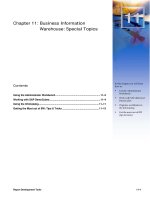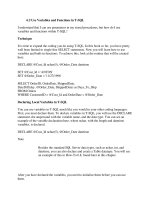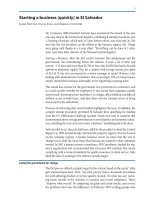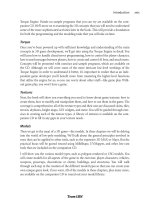Tài liệu Starting a business (quickly) in El Salvador ppt
Bạn đang xem bản rút gọn của tài liệu. Xem và tải ngay bản đầy đủ của tài liệu tại đây (147.09 KB, 7 trang )
9
On 24 January 2006 President Antonio Saca announced the launch of the new
one-stop shop at the Commercial Registry, combining 8 startup procedures into
1. Starting a business, which took 115 days before reform, now took only 26. e
next day the vice president cut the ribbon at the business registry site. ings
were going well, thanks to a 4-year eort. “Everything can be done in 1 place
now,” says Felix Sae, director of the National Central Registry.
Starting a business, oen the rst contact between the entrepreneur and the
government, was intimidating before the reforms. It took a lot of time and
money—115 days and more than $2,700 in fees, plus $2,850 that had to be paid
upfront as minimum capital. is, for a country with average income per capita
of $2,145. It was not uncommon for a senior manager to spend 10 hours a day
dealing with administrative formalities. Not surprisingly, 38% of entrepreneurs
simply started their business informally, never registering or paying taxes.
is meant less revenue for the government, less protection for consumers, and
no social security benets for employees. It also meant that companies usually
stayed small. Investing in new machinery or a bigger oce building was dicult
without access to bank loans. And then there was the constant worry of being
discovered by the authorities.
Pressure started rising aer several studies highlighted the issue. In addition, the
complex startup procedures prevented El Salvador from qualifying for funding
from the U.S. Millennium Challenge Account. Funds went only to countries that
demonstrated above-average performance on several policy and economic indica-
tors, including the time and cost to start a business. Something had to be done.
Sae decided to act. Since he had been called by the president to head the Central
Registry in 1999, he had already reformed the property registry. Now he focused
on the company registry. A former business owner, he knew that the way to
change was to shi the focus from what bureaucrats wanted to what customers
needed. In 2001 a human resource consultancy, HG Consultores, studied the reg-
istry’s organization and recommended that it become ISO-certied. is meant
complying with a series of standards for quality assurance in client service. Sae
liked the idea. It would give the reform a specic target.
Laying the groundwork for change
e ISO process oered a simple target for the reform, based on the motto “what
gets measured gets done.” First, “say what you do,” that is, document procedures
for work aecting product or service quality. Second, “do what you say,” mean-
ing retain records of the activities to measure and record compliance. ird,
“improve what you do” by comparing set goals and actual results, and correct
the problems that cause the dierences. In February 2003 working groups were
Starting a business (quickly) in El Salvador
J N, S S, A V
10
formed to analyze 3 lines of work: company documentation (such as commer-
cial registration), the business license, and the registration of the initial balance.
“is review process is what took the most time, almost a whole year,” remem-
bers Manuel del Valle, whom Sae nominated as the new director of the Com-
mercial Registry in June 2003, “but the bulk of the work was done.”
And since most of it was done in-house, costs were low. Outside experts on ISO
standards provided some initial training and guidance, but soon the registry’s
employees took over. ey also wrote the new ISO manual (Documentación de
Sistema de Gestión de la Calidad or Quality Management System Documenta-
tion). It outlined for all employees a narrative and schematic map to guide them
through their and (everyone else’s) processes within the registry. e guidelines
also specied how to correct mistakes and make sure that they are not repeated.
Each employee has a copy of the manual and is able to refer to it. Monthly meet-
ings reassess the rules. Any changes are published on the registry’s website.
Once the baseline procedures were documented, the reforms started in Novem-
ber 2003. “Everyone had been involved from the beginning and was ready to
go,” says del Valle. First, the sta was organized into small teams. Each employee
was part of a team according to his or her work stream and task (grupo natural)
and a reform group (grupo de proyectos de mejora). e teams met every week
to discuss their previous work week, what went wrong, and how to improve it.
During the week sta measured response times and thought of ways to cut or rear-
range inecient processes. All meetings were documented with action items for
follow-up the next week.
Starting a Business
CASE STUDY: EL SALVADOR
FIGURE 1
Reducing time and cutting costs to start a business in El Salvador, 2004 and 2006
Total time cut
from 115 days
to 26
Procedures cut
from 12 to 10
2004
2004
2006
2006
Source: Doing Business database.
1 12 1 12
Procedures Procedures
Time (days)
Cost
(% of income per capita)
0
20
40
60
80
100
120
140
0
20
40
60
80
100
Cost cut from 128%
of income per capita
to 76%
11
The customer as evaluator
To check on implementation and measure results, a new quality control unit was
created. It solicited comments from the registry’s customers on the quality of ser-
vice through written and phone surveys and a prominently displayed suggestion
box. So-called mystery shoppers, dierent people contracted by the quality con-
trol unit, tested the friendliness of client service and processing times. e results
of these surveys were used to see where further improvements were needed.
e eorts paid o. Aer a year of hard work the major bottleneck, processing
business licenses, was xed. e time to start a business fell from 115 days to 40
by January 2005. e original goal of 85% customer satisfaction was exceeded. In
March 2005 the registry became ISO certied, the rst in Latin America.
ings also started moving at the top of the government. In the presidential cam-
paign of 2003-04, soon-to-become-president Antonio Saca promised to launch
a program called Programa Presidencial—El Salvador Eciente. e program
would improve the local business environment by cutting red tape.
In the 1990s the government’s economic policies had focused on ensuring
macroeconomic stability. Successfully: the country recovered strongly aer the
end of the civil war. But economic growth slowed to an annual average of 3.9%
in 1995–99, and 1.9% in 2000–04. Concerned about this trend, President Saca
realized that macroeconomic stability was not enough. Red tape was tying down
businesses and holding back investors, both domestic and foreign.
With an increasingly open market, competition was only becoming stronger. El
Salvador had been negotiating the Dominican Republic–Central America Free
Trade Agreement. In December 2004 it was the rst country to ratify the agree-
ment. If nothing was done to make doing business easier in the country, chances
were that local companies might be overrun by erce competition.
At the insistence of President Saca, Eduardo Zablah-Touche, head of the Tech-
nical Secretariat of the Presidency, developed a plan to eliminate, simplify, and
redesign bureaucratic processes that adversely aect the eciency and function-
ing of businesses. Both men knew what it was like to be a businessperson in El
Salvador. Before being elected in March 2004 Saca lobbied on behalf of private
businesses as president of the National Association of the Private Enterprise.
Zablah-Touche had been director of various companies and started a few of his
own. “e happiest moments are when a new company is born.”
Starting a Business
CASE STUDY: EL SALVADOR
12
How far can you get without changing the law? A long way
When it was time to start implementing the plan, the technical secretary formed
several reform committees to focus on red tape for trade, visa requirements,
construction and environmental permits, and closing a company. Every com-
mittee included relevant public ocials and businesses. In October 2005 the
Commission for the Study of Reforms to the Commercial Code was established
to review the commercial code and simplify business startup.
Backed by support from the President, Mayra de Morán, the director of the com-
mission, wasted no time. She wanted results quickly. She also knew that legal
reforms took time in El Salvador. “Anything that Congress has to approve takes at
least 8 months.” Her solution: let’s see how far we can get without legal changes,
just by reducing bureaucracy.
Any procedures not explicitly required by law were rst to go. Chances were
that they made little sense anyway. For example, certain ministries required that
photocopies had to have certain size margins, with additional notarizations to
ensure that the copy was accurate. Only very few photocopy businesses in San
Salvador could provide this service.
Next, a single window would be established to allow entrepreneurs to complete
formalities with dierent agencies in 1 visit. Visits had been required to 5 dier-
ent public agencies. is was not the rst time the idea of a single window had
come up in El Salvador. Already in 2000 a 1-stop shop (Ocina Nacional de In-
versiones) had been created in San Salvador, with branches opened in Sonsonate
and San Miguel in 2005. Entrepreneurs could submit all their documents, but
the sta still had to organize the registration at dierent agencies. is took time.
And many people thought that the service was only for foreign investors, though
it was also open to local investors.
e plan was to put ocials from the dierent agencies in 1 building. Most
important, they would have the authority to complete any formality by being
electronically connected to their respective agencies. Entrepreneurs would be
able to complete 8 dierent formalities in 1 place—the company registration,
the registration of the initial balance sheet, obtaining the business license, tax
ID for both income and value-added tax, ocial invoice papers, social security
registration, and the notication of the Ministry of Labor.
It was quickly decided that the customer-oriented commercial registry, with its
modern technology, would host the other agencies. To make implementation
quicker and smoother, the commission postponed its goal of introducing a single
registration form, since that might require changes in agency computer systems.
Starting a Business
CASE STUDY: EL SALVADOR
13
A busy November 2005
e Technical Secretariat coordinated the development of service guidelines
with interagency working groups and informed the public about the planned
single window. Aer a schedule was developed for reallocating the delegates
to the registry, work began in November to bring all the relevant agencies on
board and start implementing the reform. In 1 week a core group of techni-
cians, legal consultants from the aected ministries, and members of the reform
commission draed the guidelines. A day later the technical secretary met with
top ocials of the Ministry of Labor and the Social Security Institute (Instituto
Salvadoreño del Seguro Social) to persuade the 2 to reform.
It worked. “is was our great advantage,” recalls Morán. “e technical secre-
tary was not directly aected by the reform, but was linked to the presidency. We
could play the role of mediator or push for decisions when the process got stuck.”
e following week, the reform plans were discussed with all institutions involved.
Each institution chose its delegated ocials, and technicians planned the com-
puter connections.
In the third week of November equipment and people could be moved to the
registry. To save time and money, delegates at rst brought their own computer
equipment. Formalities were done on site, with the information sent electroni-
cally to the supervising agency. “ankfully, most of the other agencies were
already computerized, which made the transfer and connection much easier,”
says Morán. Only the Ministry of Labor was not. But since a simple notication
suces, the delegate can stamp the paper at the single window and have the
package delivered to the ministry at the end of the day.
On 21 November 2005 the rst tests were conducted. A few days later a random
client was asked to test the system. Based on this experience, the guidelines and
system were adjusted. Tests continued in the following weeks to make sure that
everything was ready for the ocial opening in January 2006. is time the com-
mission made sure that the reform would not go unnoticed, planning 2 major
launch events.
e reform spirit received another boost. In December 2005 El Salvador became
1 of 2 lower-middle-income countries worldwide to qualify for Millennium
Challenge Corporation (MCC) funding. (e other was Namibia.)
On 24 January 2006 the president announced the opening of the single window
together with the ocial launch of El Salvador Eciente at the presidential pal-
ace. A day later the vice president cut the ribbon at the registry in the presence
of high-level ocials from the ministries.
Starting a Business
CASE STUDY: EL SALVADOR









